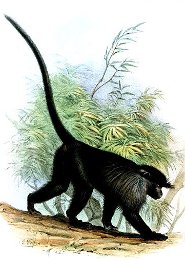 The gray-cheeked mangabey (Lophocebus albigena) is also known as the white-cheeked mangabey. This long-tailed Central African monkey has three subspecies, although biologists may soon declare one of the subspecies, Lophocebus ugandae, its own species. This subspecies is only found in the forests of Western Uganda. The other two subspecies, Lophocebus albigena albegina and Lophocebus albingena johnstoni, are found in the forests of Nigeria, Cameroon, Gabon, Equatorial Guinea, Democratic Republic of the Congo and Burundi. All three subspecies are nearly identical in behavior and appearance.
The gray-cheeked mangabey (Lophocebus albigena) is also known as the white-cheeked mangabey. This long-tailed Central African monkey has three subspecies, although biologists may soon declare one of the subspecies, Lophocebus ugandae, its own species. This subspecies is only found in the forests of Western Uganda. The other two subspecies, Lophocebus albigena albegina and Lophocebus albingena johnstoni, are found in the forests of Nigeria, Cameroon, Gabon, Equatorial Guinea, Democratic Republic of the Congo and Burundi. All three subspecies are nearly identical in behavior and appearance.The gray-cheeked mangabey is not an endangered species, according to the International Union for the Conservation of Nature. But all three subspecies rely on the forests or swamps in order to survive. The forests of Central Africa are being cut down at a fast rate. Should the forests disappear, so will all three gray-cheeked mangabeys. The monkeys are also hunted by people for their meat. The monkeys are also hunted by leopards.
General Appearance
The gray-cheeked mangabey does indeed have grey or nearly white cheeks. The rest of the long, rangy body is black or dark gray. The chest and front legs of the monkey are more powerfully built than the rest of the body.
Males grow slightly larger and heavier than females. Males can weigh up to 19.84 to 22 pounds (9 to 10 kilograms) while females tip the scales at only 14.1 to 15.43 (6.4 to 7 kilograms.) The length of a male's body, excluding the tail, can grow anywhere from 21.26 to 28.74 inches (54 to 73 centimeters.) Females only grow from 16.9 to 24 inches (43 to 61 centimeters.) Both males and females grow tails from 28.74 to 39.37 inches (73 to 100 centimeters.)
Life and Behavior
Gray-cheeked mangabeys travel about in small groups or bands lead by an alpha male who has exclusive breeding rights to the females. Troops seperate in the tree branches to feed on insects, tree gum, seeds, nuts, flowers and fruit. Since its hard to see other troop members through the heavy foliage, the monkeys have a wide array of very loud calls to keep in touch. These calls include a "whoop-gobble" from the alpha male. He has a throat sac to help project his voice.
Gray-cheeked mangabeys only live to about 20 or 30 in the wild but have been known to live slightly longer in captivity.
Keywords: brown , black , mane
The Gray-cheeked mangabey, grey-cheeked mangabey, white-cheeked mangabey is listed as Least Concern (LR/lc), lowest risk. Does not qualify for a more at risk category. Widespread and abundant taxa are included in this category, on the IUCN Red List of Threatened Species
Countries
Angola, Burundi, Cameroon, Central African Republic, Congo, Democratic Republic of the, Congo, Republic of the, Equatorial Guinea, Gabon, Rwanda, Sudan, Tanzania and UgandaSome facts about the
Gray-cheeked mangabey
Adult weight : 9.318 kg (20.4996 lbs)
Maximum longevity : 36 years
Female maturity :1460 days
Gestation : 181 days
Weaning : 233 days
Litter size : 1
Interval between litters : 584 days
Weight at birth : 0.425 kg (0.935 lbs)
Weight at weaning : 2.17 kg (4.774 lbs)

Custom Search